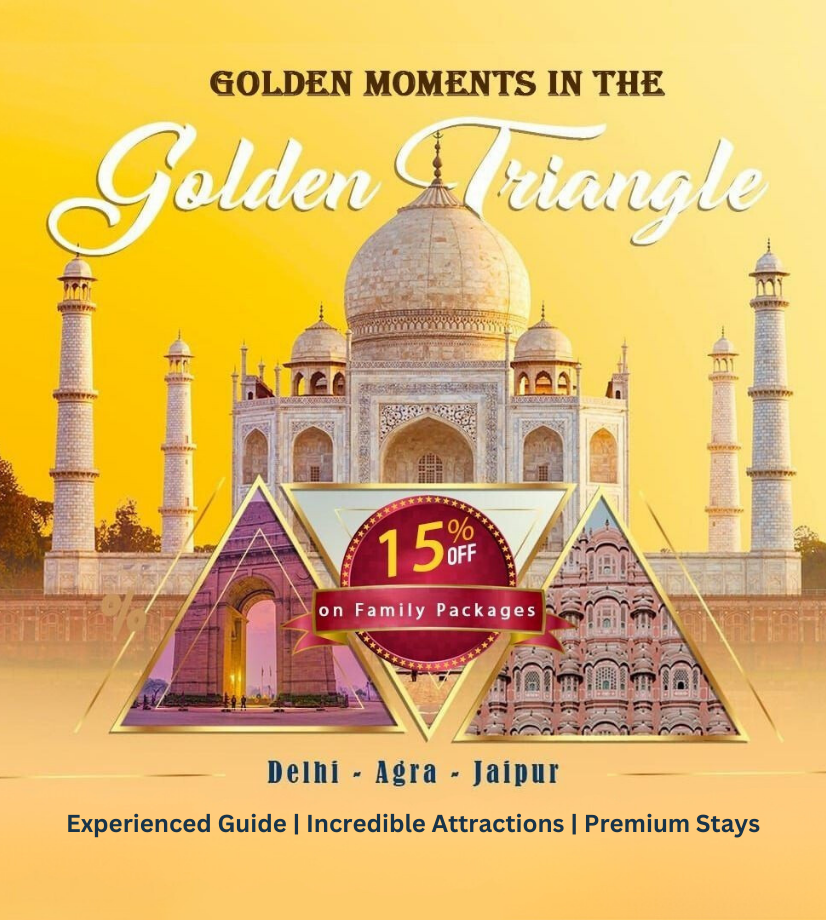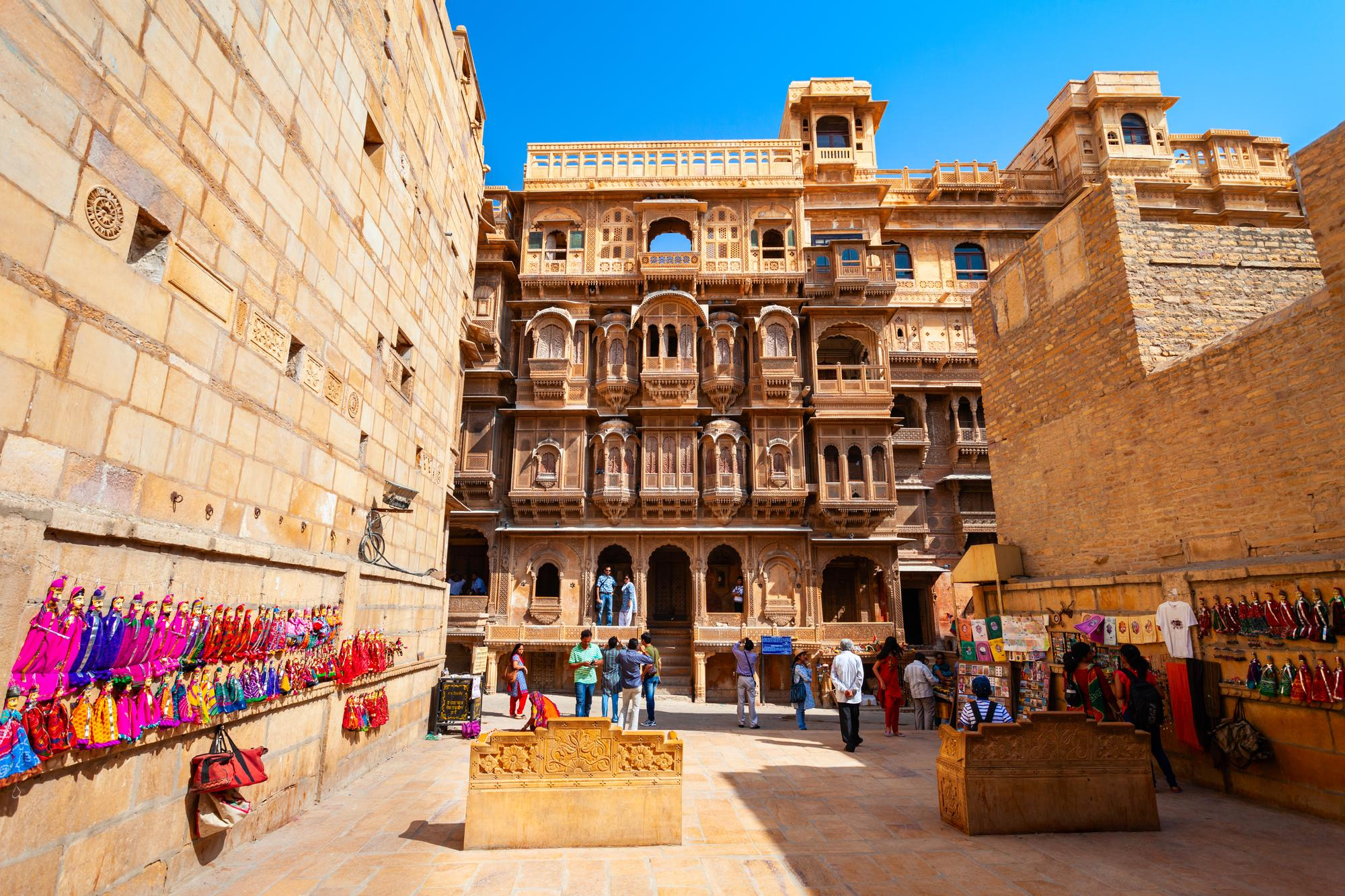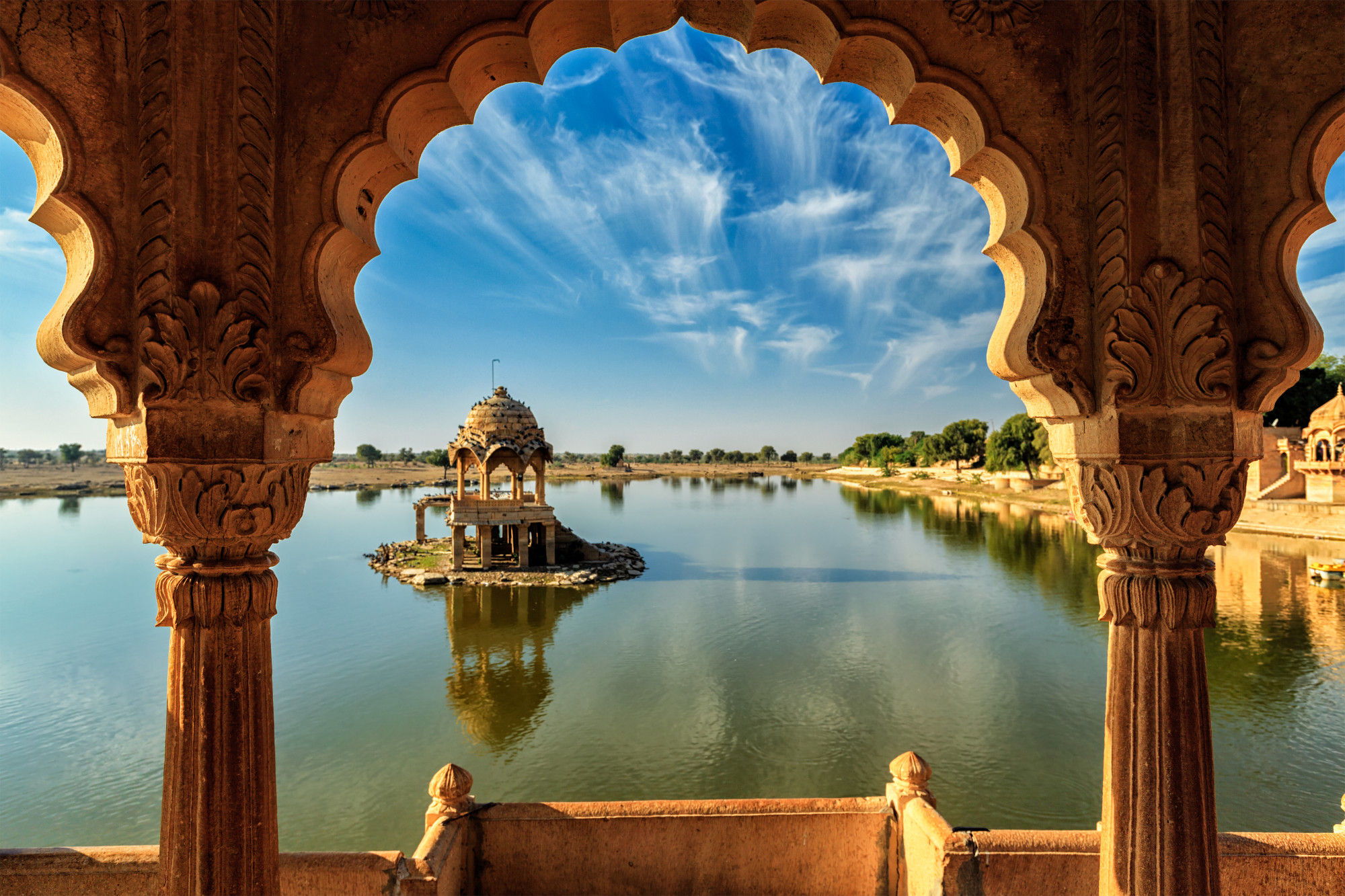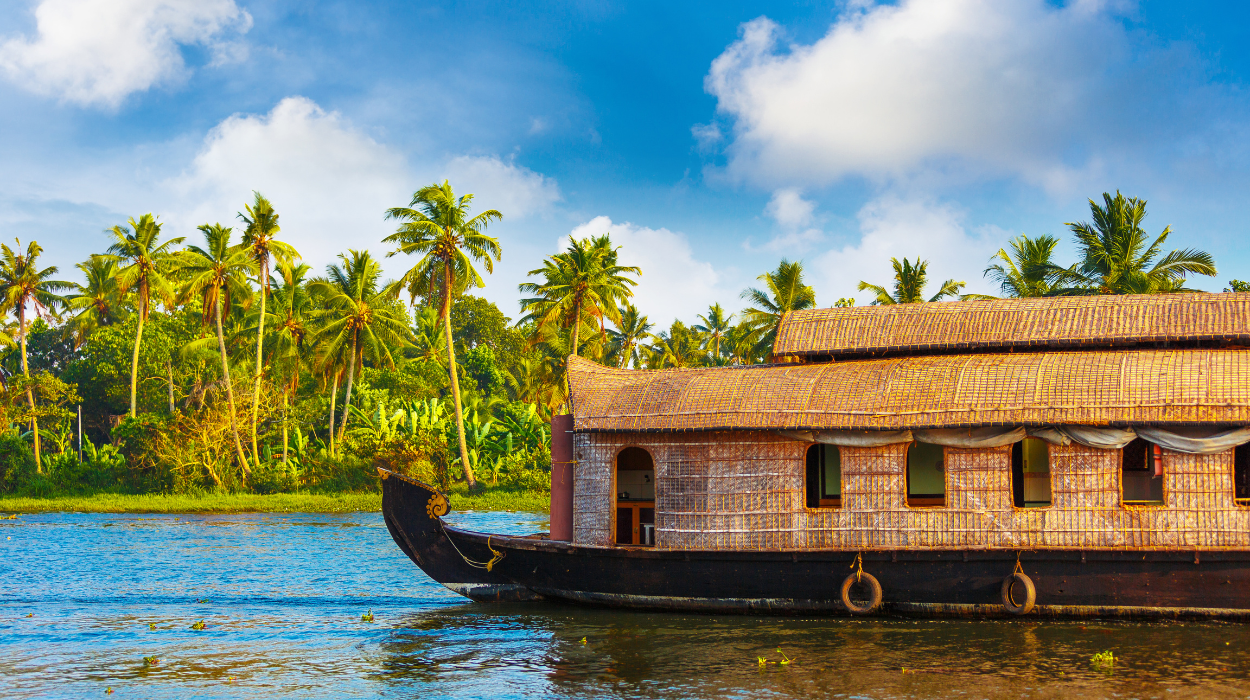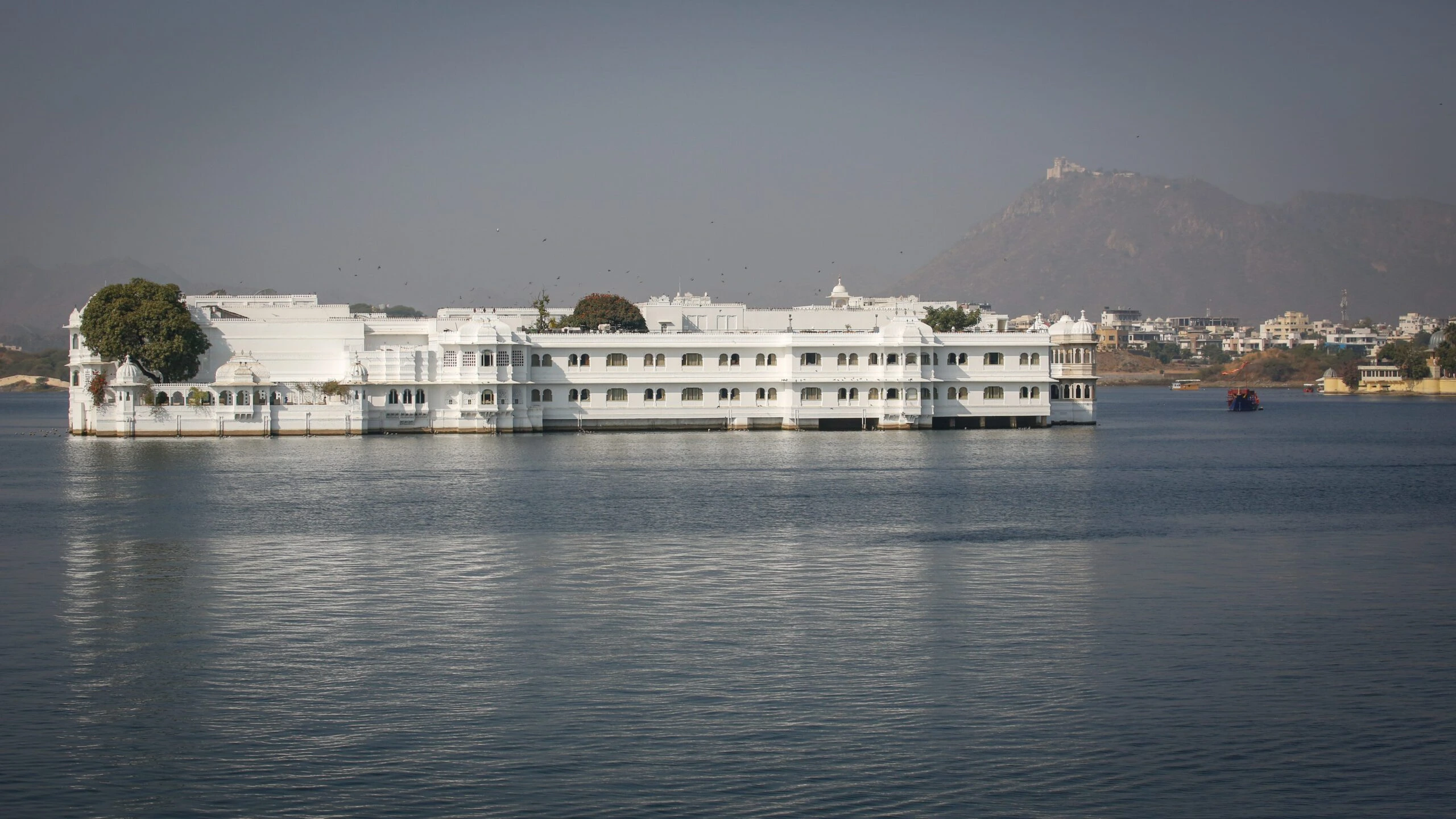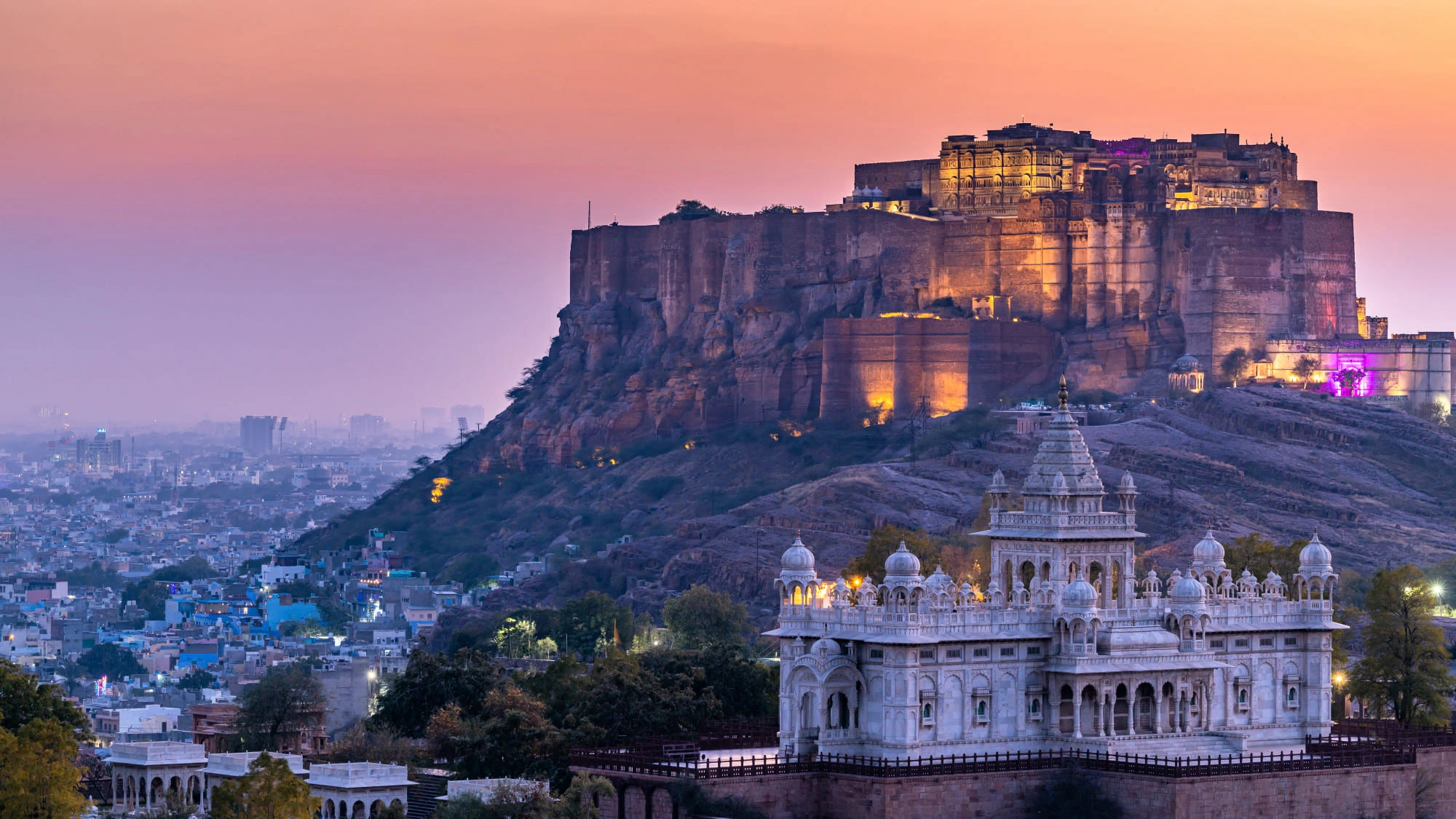India’s Pink City, Jaipur is a blend of antiquity and modernity. Each corner is a unique masterpiece of its kind though and beautiful colors and historical art go hand-in-hand. The city is so stunning from beautiful forts to pretty palaces, busy bazaars, and delicious street food, it will leave you spellbound. Come along with us to learn about these best places to visit in Jaipur.
Hawa Mahal
Hawa Mahal is popularly known as the “Palace of Winds”, Hawa Mahal is one of the most significant props in the city of Jaipur. This palace residence dates back to 1799 and was built by Maharaja Sawai Pratap Singh. Its distinctive honeycomb shape is fully decorated with 953 intricately carved windows that are a truly remarkable formation of Rajput architecture. This high structure has 5 floors and the occupants could have a nice view of city life from their fancied location. This man-made structure is a complex depiction of the opulent tradition of the land of kings i.e. Rajasthan.
The Hawa Mahal in Jaipur is often affectionately called the Wind Palace. Also located in the middle of the Pink City, the Hawa Mahal is built with red and pink sandstone, but it resembles the headgear of Lord Krishna
How to Reach
Reaching the Jaipur Hawa Mahal in India is very famous, and it is one of the great places to visit. You can reach there through public transport, by car, taxi, and auto-rickshaw.
Car: Hawa Mahal is around 5 km away from the city. You can easily rent or call for a cab and get there in fifteen minutes, taking the Mirza Ismail Road.
Bus: The closest stop to Hawa Mahal is the Badi Chopar bus stop. There are several buses in Jaipur that route here. After alighting the bus, it’d just require a short walk of a minute to reach the palace.
Auto: Autos are the most convenient mode of transport to Hawa Mahal. Take an auto from anywhere in Jaipur, and you will reach in less than 30 minutes.
Metro: The nearest metro station to Hawa Mahal is Badi Chaupar Metro Station. A minute’s walk from here will take you to Hawa Mahal.
Best time to Visit
The best time to visit Hawa Mahal is during winter or the end of the fall season as it’s not too crowded.
Best Day: Even if Hawa Mahal can be visited whenever one wants, it is always overcrowded throughout the week everywhere. So, most people prefer visiting this place in March as it’s less busy.
Best Time: This place is open 9 AM – 4:30 PM > early mornings and late afternoons are the best time as the sun is not too strong and the rays do not reflect blindingly.
Amer Fort
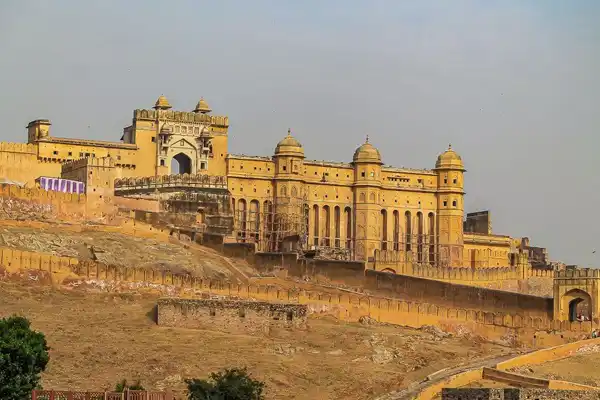
Amer fort One of the most beautiful forts ever built and it is said to cover 4 sqm. The fort seems to extend endlessly as there are plenty of tunnels and stairways that lead from one area to the next fort. It was built by Raja Man Singh I in 1592 and extends 3.5km upwards already giving a breathtaking view of the city. You can enjoy a fascinating view of Maotha Lake over the fort.
The fort stands as an ornament on the head of Jaipur. Each day, more than 5,000 tourists frequent the fort and enjoy its grandiose beauty. The Amer fort has also been inscribed into the UNESCO World Heritage List along with five other forts of Rajasthan. Discover the ancient legacy of Amer with our configured Jaipur holidays including the majestic Amer Fort and a historical excursion throughout the country.
Perched on Cheel Ka Teela in Jaipur is the stately Rajput structure of Amer Fort. Built in the 1500s, it features beautiful palaces and courtyards, including the drool-worthy Sheesh Mahal. This ancient jewel is one of the World Heritage Sites and offers stunning views. It is a jewel in the crown of Jaipur which thousands of people come to visit daily. The Amer Fort is famous for its complete construction in the style of Hindu architecture. They consist of pink and yellow sandstones that demonstrate the splendor of Rajasthan. It has high walls and intricate gates. You can go for an elephant ride around the fort and also enjoy music and light shows inside the fort.
There are many impressive works of art, such as carvings and paintings on walls, to be found in Ganesh Pol and Suraj Pol. You can also pass through the Jaleb Chowk, which has been constructed adjacent to the horse’s barracks.
How To Reach
By Bus- To go to Amer Fort, you will be able to use a bus if you take an RSRTC bus from Hawa Mahal in Jaipur. Within a span of 20 minutes the bus won’t take long to cover the 7.2 kilometers stretch to its final stop which is at the Amer Fort.
By Taxi- Use a cab, taxi, or tuk-tuk to go from Hawa Mahal to Amer Fort in Jaipur. The distance to Amer Fort by road is around 18 to 20 minutes which is 7.2 kilometers.
Best Time to Visit
Since Severe Weather conditions do not require the Jaipur tourism Amer fort to be closed to tourists, this site remains open for people to visit throughout the year. The attraction is open every month and season.
In terms of Perennial or ideal, it can be deduced that Amer Fort Jaipur’s best time to go is during the winter season which falls between September to March. Exploring the fort during winter months is a great advantage due to the atmospheric conditions being relatively preferable.
Best Day of the Week- For Amer Fort visit, it is wise to head its way during weekdays instead due to weekends being crowded making the usual exploration less relaxing and undertakable.
The best time to visit Amer Fort lies between 7 pm to 9 pm as this is the time when the visitors can experience the music and light show provided at the Amer Fort.
Shila Devi Temple
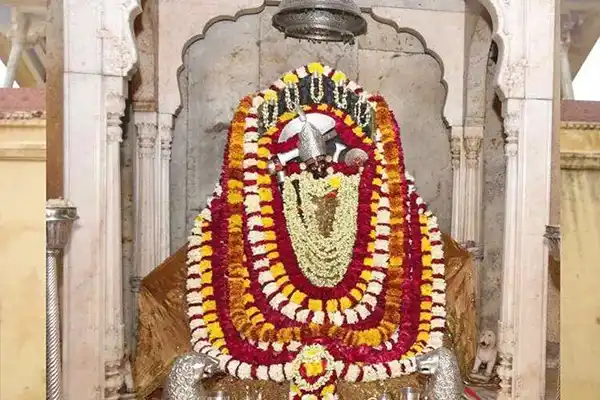
Sridevi Temple is a popular tourist attraction in Jaipur and is a temple dedicated to Goddess Durga. This temple is located in Amer Fort. In 1604, Maharaja Mansingh brought a statue of Goddess Sheila Mata from Jessore, Bangladesh. Her statue is floating in the sea.
Raja Man Singh discovered the idol in the water in the shape of a Shila (Slab), and after it was cleansed and washed, the current idol appeared, thus the name Shila Mata. Interestingly, the temple took ten years to construct.
Shila Devi Temple Entry Fee and Timings
There is no entrance fee to the Shila Devi Temple. It is open every day from 6:00 a.m. to 12:00 p.m., followed by 4:00 p.m. to 8:00 p.m.
How to Reach Shila Devi Temple
The Shila Devi Temple is reasonably simple to access using many kinds of transportation.
- By Air: Sanganer airport is 11 kilometers from the shrine.
- By train, the Ramganj Mandi Railway Station is 2 kilometers distant.
- By car or bus: The stand is 5 kilometers from the temple.
- By cab – To get to the temple anywhere in Jaipur, get a cab from one of the city’s leading vehicle rental firms.
Jal Mahal
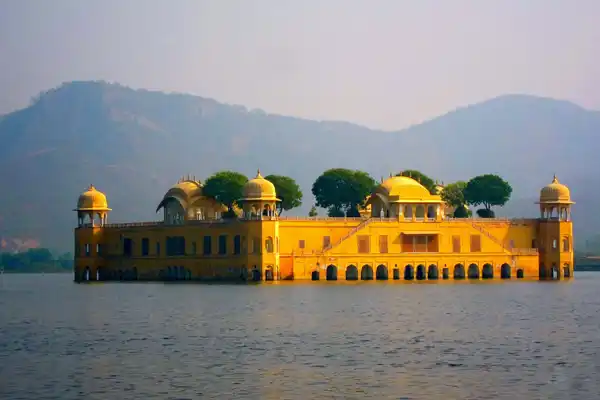
Jal Mahal aka The Water Palace refers to one of the summer palaces of Maharajas in the world and you find this amazing structure in the middle of Man Sagar Lake in Jaipur. The unique palace (mostly situated under), is a fine specimen of Rajput and Mughal architecture. Maharaja Madho Singh constructed it in the 1700s as a location for relaxation after hunting for ducks trips. Today, only the top level of its five-story structure is above water, providing amazing views of the neighboring Nahargarh hills and the lake.
Though tourists cannot enter Jal Mahal, the view from the lake’s water is amazing. The palace’s style, with red sandstone walls and elaborate Rajputana architecture, makes it a popular picture location. It reflects Jaipur’s rich heritage and is a must-see for anybody visiting the city. Jal Mahal remains an outstanding sight, particularly during sunrise or sunset when the architecture shows brightly.
How to Reach
To go to Jal Mahal, take a local bus from Jaipur’s various locations. Take a bus from the Narayan Singh Circle stop in the city centre and get off at Shahpura Bagh. It is the nearest bus stop to Jal Mahal which is 1.6 kilometers away. The palace is a 5 to 10-minute walk from here. Furthermore, some local busses are also running they can drop you at the Jal Mahal for a nominal fee.
By car: From Jaipur’s city center, take Amer Road, which goes straight to the Jal Mahal. You may complete the 8.3-kilometer journey in 20 to 30 minutes.
Best time to visit
Jal Mahal invites tourists all year, so any season is an excellent opportunity to discover its magnificence.
Best Season: The monsoon season, which runs from July to September, gives a unique appeal to Jal Mahal. The rains highlight the sandstone palace’s magnificence, making it even more magnificent.
Best Day of the Week: Plan your visit during the week to avoid the weekend crush. This guarantees a quieter experience and simpler access to boating on the nearby Man Sagar Lake.
Greatest Time of Day: The greatest views of the Jal Mahal are in the early morning or late afternoon, near dawn or sunset. The palace is not available for visitors, yet these periods offer breathtaking views of the palace and the lake. The excellent weather conditions enhance the experience.
City Palace
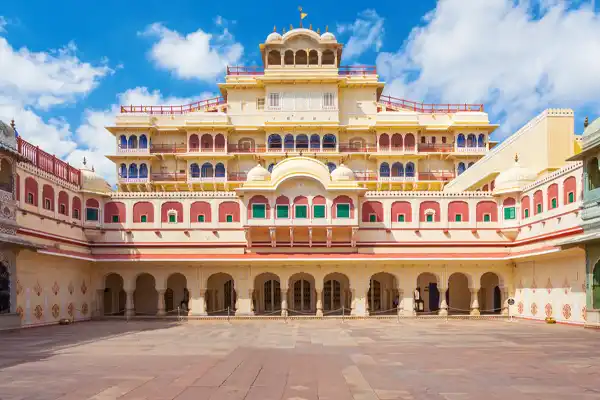
The City Palace of Jaipur is a look of Rajput and Mughal construction. It is thus also a nod to the royal tradition and craftsmanship of days gone by. Constructed in the 1700s by Maharaja Sawai Jai Singh II, this centuries-old structure occupies a significant portion of Jaipur’s center. The palace also exhibits a magnificent blend of European and Rajputana architectural styles. Its great constructions, especially the Chandra Mahal and Mubarak Mahal, are decorated with clear designs, mirror walls, and beautiful gateways. The palace and its attractions showcase the beauty of the regal nature of Rajasthan.
And the palace also remains a home for the royal family, giving a present-day interpretation to its historical narrative. The City Palace became one of the most remarkable icons of Rajasthan’s royal legacy due to its splendid history, architecture, and cultural importance.
How To Reach
1) By Flight: Jaipur International Airport is the nearest airport to City Palace. It is about 12.7 km distantly. You can hire a taxi or a cab service such as Ola or Uber to reach the palace directly from the airport. It takes about 30 to 45 minutes to drive there under normal circumstances. If you are looking for a more wallet-friendly option, local buses and auto-rickshaws are available from the airport (50rs) to the City Palace.
2) By Road: From the Jaipur city core, the City Palace is located approximately 4.8 km away. The palace is located in Jaipur’s ancient city district, which is simply reachable from the city centre. You may take an auto rickshaw, cab or even catch a ride on a local bus to go to the Palace. The complete travel to the palace takes roughly 15 to 20 minutes by car.
3) By Train: Jaipur Railway Station is an important junction of the Indian railway network. Its distance from City Palace is approximately 5.4 km. From the station, you can book up a cab or auto rickshaw (a kind of taxi) which will take you to the palace in 15 to 20 mins. Conveniently, there are prepaid taxi booths and app-based cab services available outside the station.
4) By Metro: Jaipur metro is a fast and convenient way to reach near City Palace. Chand Pole Metro Station is the closest metro station to this palace, around 1.9 km away. It is a ten to fifteen minutes drive (0.7 km) to City Palace via auto-rickshaw or walk from Chand Pole.
Best Time To Visit
City Palace invites guests all year round. Its lasting magnificence surpasses the tests of time.
excellent Day: Weekdays are excellent for visiting City Palace. This is when there are less tourists here, giving you more room and time to explore the palace’s beautiful intricacies without the bustle.
Best Time of the Day: Plan your visit to the palace between the early morning and late afternoon hours. This lets you explore the castle in cooler temps. Additionally, it also allows you adequate time to cover the large complex. Normally the City Palace is open from 09:30 a.m. to 05:00 p.m. The City Palace then reopens from 07:00 p.m. to 10:00 p.m. for the light and sound show that begins daily, at 07:30 p.m.
Chandbawari
In case you are in Jaipur, Rajasthan, you should visit Chand Baori. One such magnificent design marvel is Chand Baori, also called the Abhaneri Stepwell, a historical well in the village of Abhaneri near Jaipur. Built in the ninth century, it’s among the deepest and largest stepwells in the world.
The construction was meant to conserve water. What stands out most about this stepwell built by King Chand Raja of the Chandela dynasty is that it descends 12 feet with each floor, for a total depth of almost 98 feet. 3,500 small stairs are constructed in a perfect mathematical arrangement that descends to around 20 meters (65 ft).
For a traveler who enjoys visual spectacles with inverted pyramids, this location becomes even more appealing. The step well is square and features an outstanding symmetrical design with many layers of stairs.
When you go further into the socio-cultural context of this great edifice, you will have a clearer understanding of its dual function. Previously, when there was no rain for months on end during the dry season, communities relied on such wells for their basic requirements, such as drinking water.
Nahargarh Fort
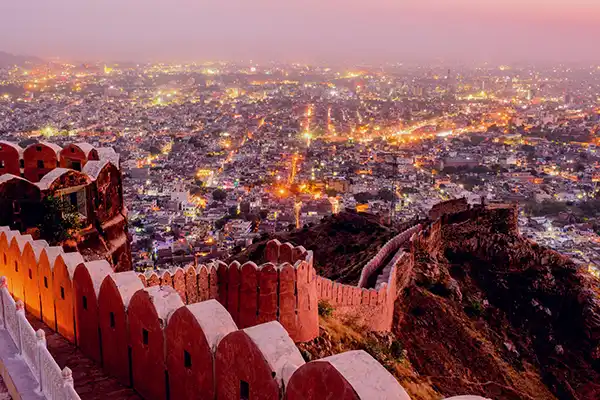
The Nahargarh Fort is located on the Aravalli Hills and offers the best views of the whole of Jaipur city. Built-in 1734 by Maharaja Sawai Jai Singh II, it features a blend of Indian and European design.
The fort, which was previously a royal retreat, is most known for its Madhavendra Bhawan, which features beautiful paintings. History lovers will enjoy the tales of ghostly pasts and gorgeous structures. It is a great place to watch the sunset or catch a glimpse of Rajasthan’s royal heritage.
The fort is not only a historical monument to Rajasthan’s glorious past but also an example of Indo-European architecture. Madhavendra Bhawan, the fort’s most well-known structure, was constructed as a royal family summer getaway. This two-story building is a wonderful combination of beauty and history, with separate chambers for the king and queens. The entire fort is fully crafted, with delicate decorations and stunning paintings. Jaipur holiday packages combine tradition, culture, and adventure, providing an amazing experience.
How to Reach
Jaipur International Airport is the closest airport to Nahargarh Fort. It is about 25.5 miles away. You can either grab a cab or an auto-rickshaw to get to the fortress from the airport.
The travel will take around one hour. You may also catch city buses along the route, but these may take longer. From the base of the fort, take another auto rickshaw uphill.
By Road: Jaipur has excellent road connectivity, and Nahargarh Fort is quite close via Amer Road and National Highway 48. Taxis, cars, and buses frequently use this road. The 18.4-kilometer trip to the fort takes approximately 45 minutes from the city center. If you rent a car you can easily get there.
By Train: The nearest major railway station to the fort is Jaipur Railway Station. It is about 18.9 kilometers away. From the station, you can take a cab, auto-rickshaw or bus to the fort, which is about a 45-minute or hour-long ride away.
By Metro: The metro can be taken if you’re traveling from Jaipur’s city center. Take the Pink Line and get off at Chandpole Station. It is also the closest metro station to the fort, 15.5 kilometers away. Now take a cab or auto-rickshaw to the fort (30-35 mins).
Perched on a tall platform, it grants expansive views of Jaipur. For its architectural beauty and craft of reconstruction, it also depicts contemporary time as well, hence a roll back the clock.
Best Time to Visit
Nahargarh Fort is open year-round. Perched above Jaipur, it provides beautiful views throughout the year.
Best Day of Week: Weekday visits are encouraged. This is when there will be less tourists, allowing visitors a more personal encounter with the fort’s spectacular architecture and uninterrupted panoramic city views.
Time of Day: Fort must be visited in Evening time, its Sunset time. The changing colours of the sky during this period provide an incredible contrast to the fort, making it a visual delight. Plus, the slightly cooler temperatures at night make it a good time to see and enjoy the surroundings.
Albert Hall
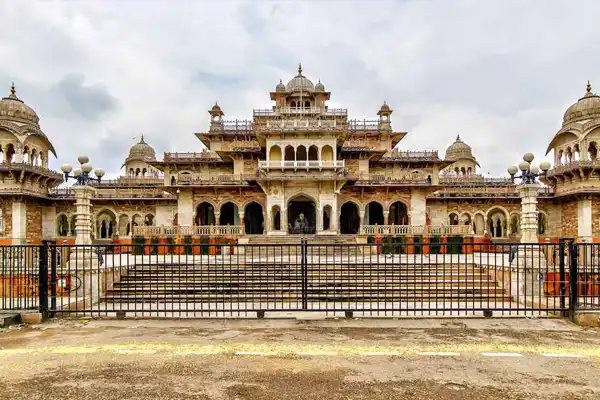
Albert Hall Museum, Jaipur Albert Hall Museum, is situated in Jaipur, tucked in between the green stretches of Ram Niwas Garden. This architectural beauty, built in 1876, is the oldest museum in Rajasthan.
The museum is also a showcase for Indo-Saracenic architecture. There is a beautiful combination of Victorian and Indian artistry here.
The museum’s history is equally intriguing as its collections. The museum was initially designed as a performance hall. Maharaja Sawai Madho Singh II’s vision led to its transformation into a museum. Today, the museum has a diverse collection of items that showcase Rajasthan’s creative and cultural legacy. By evening, the museum has transformed into a stunning lit spectacle. The glittering lights further emphasize the museum’s architectural splendor.
How to Reach
By Road: The Albert Hall is near Ajmeri Gate in Ramniwas Bagh, accessible via road. It is around 2 km from the city core.
By Bus: Take a bus from the Narayan Singh Circle stop in the city center to the Maharaja College stop. The museum is 600 meters distant, and you can walk there in 5 minutes.
By Car: If driving, take MI Road and follow the signage to the Albert Hall Museum. Parking is accessible around the museum. The travel from the city center might take around 10-15 minutes.
Best Time to Visit
This year-round venue to explore is the Albert Hall Museum of Jaipur as a part of the event of tendance essays for exams and a more desirable way of putting a step ahead of time.
Best Day: To avoid crowds, go on a weekday when you can explore without interruption. You can see all of the exhibits and have a tour of the museum without being rushed.
Mornings are the best time to visit the museum. With fewer people, you can take your time exploring all of the exhibits. Additionally, visit the museum at sunset to see it gorgeously lighted up.
Birla Mandir
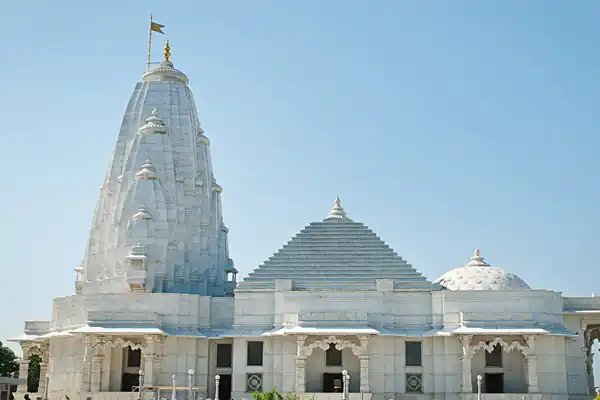
Birla Mandir, also referred to as Laxmi Narayan Temple, is a modern Hindu temple located in Jaipur, Rajasthan. The temple was built by the Birla family in 1988 and is devoted to Lord Vishnu and Goddess Laxmi. The temple is famous for its beautiful marble carvings and clear sculpture
Birla Mandir, Laxmi Narayan Mandir, Jaipur Moti Dungri Temple. The temple is a major Hindu pilgrimage site. It appears magnificent, the buildings white marble gleaming. Birla Mandir: A jaw-dropping spot to find spiritual calm in Jaipur Tourism, The place takes the cake of being highly elaborate in marble sculptures.
How to Reach
By Road: The temple is 11.8 kilometers from the city center. You may take a hired automobile or a cab to visit the temple in around 20 minutes via Elevated Ajmer Rd/Jaipur Rd.
By Metro: The nearest metro station to Birla Mandir is Ram Nagar Metro Station, around 6 km away. From the metro station to the temple, you can also take a rickshaw.
By Train: The temple is 6 km from Jaipur Railway Station. You may take a rickshaw to the temple from the station.
Best Time to Visit
Visit the Birla Temple in Jaipur at any time of year for its stunning appearance. As a result, the attraction is open every day.
Best day of the week to visit: Any weekday, as weekends are overcrowded. If you’d rather avoid crowds, also don’t go on festival days.
The best time of day: Visiting hours are generally from 8 a.m. to 12 p.m., and 4 p.m. to 8 p.m. daily. But the best time of day is sunset, when the westering sky’s soft light lights its white marble in a spiritual way. In the evening, the temple is beautifully illuminated, making it even more beautiful. Going in the evening, you’d also be able to see aarti and other rites.
Handicraft Market
Jaipur’s cultural past is broad, incorporating the finest of many different civilizations into one. It is clearly seen in its traditional handicrafts and local art. Jaipur’s marketplaces are brimming with such trademark things, whether in apparel, furniture, footwear, accessories, or even cuisine.
Rajasthani craftwork has a special quality that attracts tourists. All of their creations have vibrant colors, exceptional craftsmanship, indigenous variances, royal delicateness, and innate beauty. There are several wonderful objects that one would like to bring home. These handmade goods make fantastic presents as well as unique discussion pieces.
Here we discuss the most prominent handicraft marketplaces in Jaipur, which can save you time and direct you to your desired item. Each is a great spot to visit, so take your time exploring and you won’t be disappointed.
Bapu Bazaar
Bapu Bazaar is a one-stop shopping strip that sells practically everything available in the other marketplaces. This location is sometimes noisy, busy, and colorful, yet it is full of energy and great collectibles. This store specializes in selling Jaipuri products like as dupattas (traditional veil), juttis (footwear), sarees, Kurtis, scarves, wedding Lehengas, and lac bangles at moderate prices.
Johari Bazar
Johari Market Owing to its Jeweller’s Market is a known handicraft market at Jaipur. A long row of stores that look the same but are bustling has every niche of your jewelry needs covered. Kundan and Polki, Thewa and Meenakari, Jaipur’s own jewelry studded with garnets, rubies, sapphires and other gemstones, are easily available in a range of traditional and contemporary styles.
Tibet Market
Jaipur’s Tibet Market offers a look into Tibetan culture. A great site for budget consumers to purchase for handicrafts, clothes, furniture, home décor, woolens, and much more. If you visit Jaipur during the winter months, from November until the end of January, you may take advantage of this seasonal market for some great prices.
Nehru Market:
Nehru Bazaar is one of Jaipur’s best handicraft markets packed with shoppers with a variety of beautiful clothes and textiles. Out of all of them, the native shoe version of Mojris steals the act. It’s a bright and comfortable option in a slew of styles, embroidery and colors, so it’s hard to choose just one.


